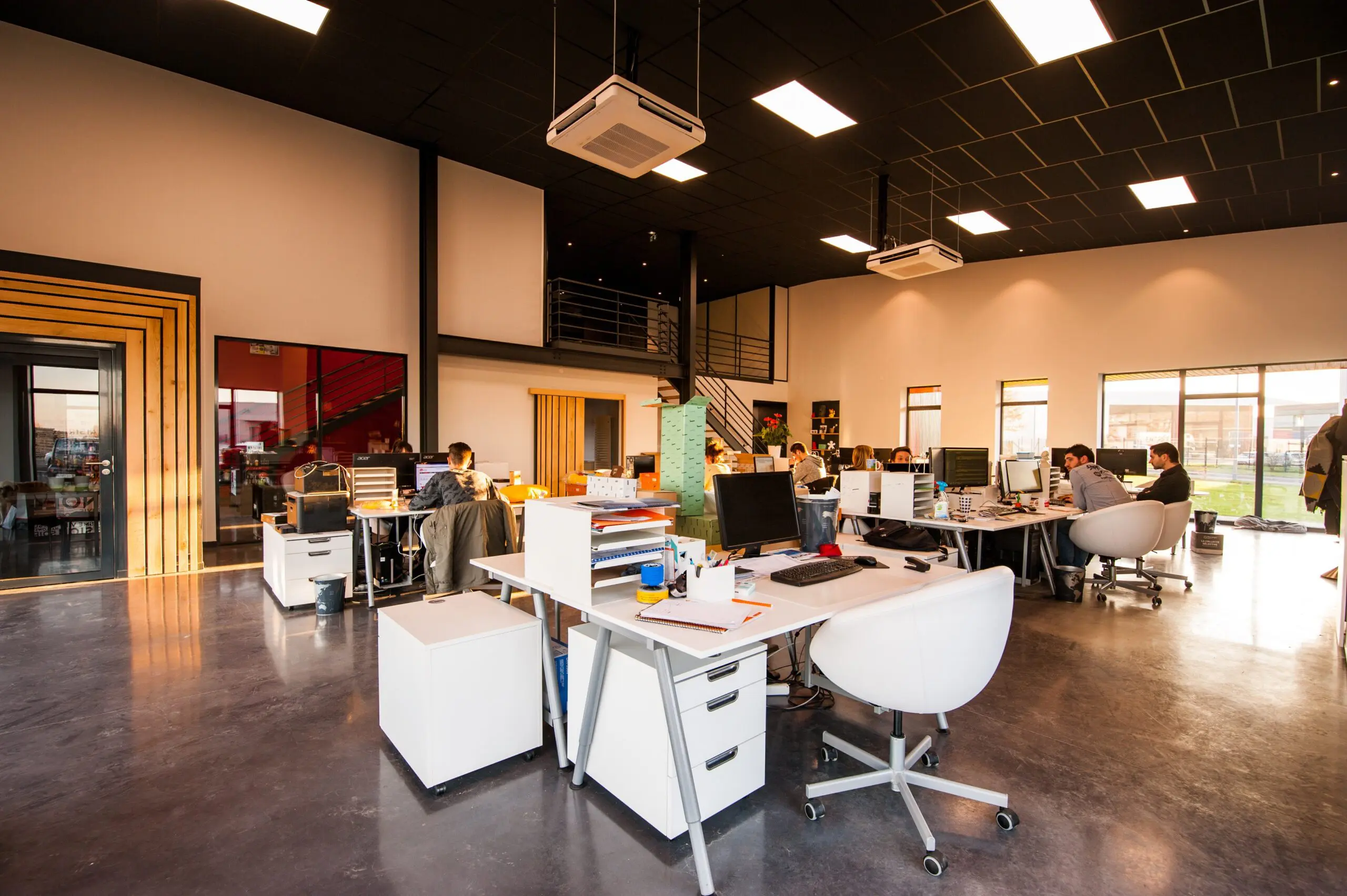

Pests are a hazard in virtually every industry, and office buildings are no exception. All pests, even nuisance pests, pose some level of danger to office employees. Read on to learn which pests are most common in office buildings, what attracts them, and how to keep them out.
Common Pests Found In Office Buildings
Ants
Ants are tiny, omnivorous insects that are found throughout the world. Typically black, brown, red, or yellowish, these arthropods are between 5 and 15 mm long. They have chewing mouthparts and very skinny waists. The most common ant species in North America are carpenter ants, odorous house ants, fire ants, pavement ants and pharaoh ants. Ants are mostly a nuisance, but they can spread bacteria, contaminate food, cause structural damage, and bite.
Ants are one of the most commonly encountered insects in both professional and residential settings, due in part to the fact that they will eat just about anything. An ant’s regular diet consists of things like human and pet food, animal carcasses, insects both dead and alive, plant nectar, fungi, and even the “dew” that insects like aphids excrete. Because of their diverse diet, ants are remarkably easy to attract.
Signs of ant activity include ant trails, dirt, ant hills outdoors, wings that have been shed, and dead ants. In the case of carpenter ants, you may also notice pinholes in walls and wooden structures, small sawdust piles near the holes, and a rustling sound in the walls.
Cockroaches
Cockroaches have broad, flat bodies and small heads. Most species are either reddish-brown or dark brown in color. There are approximately 30 species of cockroaches that are associated with human habitats, the most common being American and German cockroaches. All cockroaches have long and flexible antennae as well as two ocelli, which are eyes that only detect movement, not complex images.
Cockroaches are widely known as dirty pests because of their proficiency at spreading disease. They hang out in some filthy places like dumpsters and sewers. While in such places, cockroaches pick up all sorts of bacteria, pathogens, and parasites. They then spread these germs to every surface they crawl across, including food and food prep areas, which can lead to serious illness. What’s more, cockroach infestations can cause allergic reactions and asthma flare-ups.
Cockroaches are attracted to any kind of food source including spills, crumbs, dirty dishes, garbage, pet food, and more. They are also drawn to water sources and dark, damp environments. Signs of a cockroach infestation include droppings, shed exoskeletons, egg capsules, and a foul, musty odor.
Flies
There are quite a few fly species that plague office spaces- fruit flies, mosquitoes, house flies, black flies, and drain flies, to name a few. Most flies are somewhere around ¼ inch in size, but some species, like fruit flies, are even smaller. Flies often bite, leaving itchy or painful welts that can lead to secondary infection or, if the fly was infected, disease. In addition, they are known to spread harmful bacteria and pathogens wherever they land.
A fly’s diet depends on its species, but most are attracted to things like leftovers, rotting fruits and vegetables, dead animals, alcohol containers, and even feces. The main indicator of a fly infestation is seeing them buzzing around.
Pantry Pests
Pantry pests are insects that infest pantry foods. They are usually moths or beetles, with some of the most common species being meal moths, cigarette beetles, flour beetles, sawtoothed grain beetles, and bean weevils. Pantry pests can cause hundreds of dollars in food waste, as any stored food that is infested needs to be thrown away. If pantry pests have invaded, you will find the pests and their droppings in and around packaged foods.
Rodents
Rodents are an extremely common (and hazardous) pest. Mice, rats, chipmunks, and squirrels will scavenge in office buildings for food, water, and shelter. Rodents vary greatly in appearance, but all species have long front teeth. They will eat just about anything, so virtually any food source will attract them- including dead rodents.
Rodents carry a number of diseases, as well as parasites like fleas and ticks. They contaminate everything they touch, and they are known for leaving droppings and urine everywhere. They also cause considerable structural damage through chewing, scratching, and nest building.
The indicators of a rodent infestation are droppings, grease marks, chew marks, shredded materials, nests, and a scratching sound in the walls.
Spiders
Spiders often hang out in the low-traffic corners of office buildings. There are quite a few spider species, all of which have four pairs of legs, fangs, and either six or eight eyes. Some of the most frequently encountered indoor species are wolf spiders, jumping spiders, daddy long legs, orb weavers, black widows, and brown recluses. Most spiders are able to bite, but they usually keep to themselves unless threatened. Spider bite reactions differ depending on the spider’s species and the person who was bitten, but most bites just leave a painful welt. Brown recluse and black widow spiders are poisonous, and their bites warrant medical attention.
A spider’s main food source is insects, and they will go wherever the food is abundant. They are also attracted to dark, low-traffic areas. Evidence of a spider infestation includes webs, egg sacs, and spiders themselves.
Office Building Pest Prevention
In order to prevent office pests of all kinds, there are certain measures that office members must abide by. Employees should be educated on the importance of pest prevention, and should be asked to take the following precautions:
- Properly store food. All food, including leftovers, should be kept in airtight containers made of hard plastic or another hard material that cannot be chewed through. If a proper storage container is not available, consider refrigerating or freezing the food being stored.
- Clean often. A few crumbs can be a feast for a small pest, so cleanliness is key. Food spills, dirty dishes, and empty unrinsed drink containers will attract most pests.
- Regularly empty garbage receptacles. Pests scavenge for food in garbage cans. In addition, rotting food that has been thrown away is a major attractant to pests like flies. As such, all receptacles should have tight-fitting lids. They should also be emptied nightly and washed regularly.
- Eliminate entrances and pathways. Most pests can and will squeeze through tiny cracks to reach a source of food or warmth. Openings not only allow pests to enter from the outdoors- they also allow them to move freely between offices, causing infestations to spread quickly. Be sure to seal all pest entranges both indoors and outdoors, including gaps around doors and windows, cracks in the walls or foundation, and gaps around utility wire entrances. Chimneys and vents should also have screens or covers.
- Report any leaks or clogs. Moisture buildup is an environmental trait many pests love, so it should be avoided where possible. Ask employees to promptly report clogged drains and leaky faucets or pipes so they can be repaired before attracting any unwanted guests.
- Report any signs of pest activity. Infestations are easiest to eradicate when they are caught early. Ask employees to immediately report any signs of pest activity so that a pest control treatment can be scheduled.
- Have a recurring pest control treatment plan in place. Receiving regular pest control treatments is the best way to prevent infestations. Excel’s Integrated Pest Management approach targets pests’ habits and biology, eliminating the need for disruptive treatments like fumigation. IPM is applied in a way that poses virtually no risk to humans.
At Excel, we work with our customers to build the perfect pest control plan. We will discuss with you which pests are a problem and tailor a treatment plan to comply with your office’s schedule. Ready to get started? Visit our Office Buildings Pest Control page, or give us a call today!






